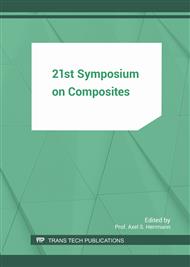p.70
p.74
p.82
p.90
p.99
p.106
p.113
p.121
p.129
Adaptation of TiC Hard Particles Properties and Morphology in Metal Matrix Composites by Refractory Elements
Abstract:
High mechanical loads, corrosion, and abrasion decrease the lifetime of tools. One way to increase the wear resistance of tool materials can be achieved by adding hard particles to the metal matrix such as titanium carbide, which protect the softer metal matrix against abrasive particles. This material concept is designated as metal matrix composite (MMC). Ferro-Titanit® is such MMC material, possessing high wear and a simultaneously high corrosion resistance, for which reason this material is used in the polymers industry. The material concept is based on a corrosion-resistant Fe-base matrix with up to 45 vol% titanium carbide (TiC) as a hard particle addition to improve the wear resistance against abrasion. These TiC hard particles must be adapted to the present tribological system in terms of hardness, size and morphology. This study shows how the size and morphology of TiC hard particles can be influenced by the refractory element niobium (Nb). Therefore, the element Nb was added with 2 and 4 mass% to the soft-martensitic Ferro-Titanit® Grade Nikro128. The investigated materials were compacted by sintering, and the densified microstructure was further characterized by scanning electron microscopy (SEM), energy dispersive spectrometry (EDX), and optical image analyses. Furthermore, microstructure and properties of the compacted Nb-alloyed samples were compared to the reference material Nikro128. The results show that the addition of Nb influences the morphology, size and chemical composition of the TiC hard particle. These changes in the hard phase characteristics also influence the materials properties. It was shown that the phase niobium carbide (NbC) is formed around the TiC during the densification process, leading to a change in morphology and size of the TiC.
Info:
Periodical:
Pages:
99-105
Citation:
Online since:
July 2017
Authors:
Price:
Сopyright:
© 2017 Trans Tech Publications Ltd. All Rights Reserved
Share:
Citation:


